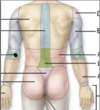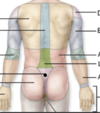Lab 1 Flashcards
the body’s ability to maintain a relatively stable internal environment despite the changing conditions of the external environment
homeostasis
In front of the body
anterior/ventral
The back of the body
posterior/dorsal
at the head end
cranial
at the rear or tail end
caudal
toward the middle of the body
medial
away from the mid-line of the body
lateral
at the surface/on the outside
superficial
on the inside, internal to another structure
deep
closest to the point of attachment to trunk
proximal
furthest from point of attachment to trunk
distal
a vertical plane that divides the body or organ into anterior and posterior parts.. When taken through the trunk, the anterior portion contains the chest and the posterior portion contains the back and buttocks.
What color portion?

coronal (frontal) plane
purple
divides the body or organ into superior and inferior parts. If taken through the middle of the trunk, the superior portion contains the chest and the inferior protion contains the abdomen.
- parallel with the floor
What color portion?

transverse plane
green
vertical plane and divides the body or organ into left and right halves on the midline. Through the head will split it into a left half and a right half (each containing one eye, one ear, and half of the nose and mouth)
What color portion?

sagittal plane
Blue
the back of the body
What does it contain?
dorsal body cavity
Contains the cranial and vertebral cavity
contains the brain

cranial cavity
contains the spinal cord

vertebral cavity
front of body
What does it contain?
ventral cavity
contains the thoracic and abdominopelvic cavity
separated by the diaphragm
contains heart and lungs
composed of?

thoracic cavity
composed of the pleural cavity, pericardial cavity, and mediastinum
lungs

pleural cavity
heart

pericardial cavity
the middle of the body
what does it contain?

mediastinum - between the two pleural cavities
contains the pericardial cavity
contains the digestive and reproductive systems
composed of
abdominopelvic cavity
composed of the abdominal cavity and pelvic cavity
contains the digestive system

abdominal cavity
contains urinary bladder, reproductive organs, and rectum

pelvic cavity
Quadrants
What do they contain?
RUQ LUQ
RLQ LLQ
RUQ contains liver and gallbladder
LUQ contains stomach, pancreas, and spleen
RLP and LLP contain intestines
opposite from how you see them normally
Regions
Right hypochondriac/epigastric/left hypochondriac
right lumbar/umbilical/left lumbar
right iliac/hypogastric/left iliac
abdomen

abdominal
forearm

antebrachial






























